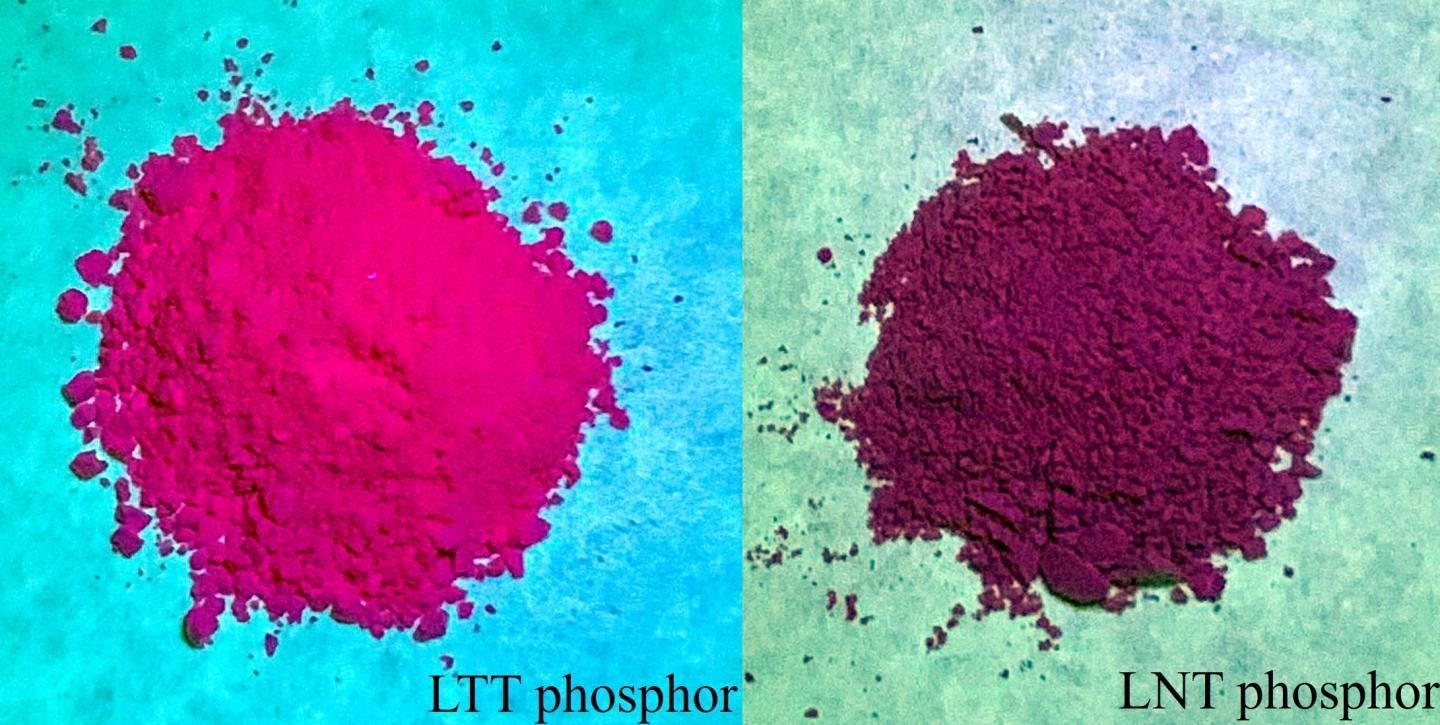Hiromi Nakano, a professor from the Toyohashi University of Technology, utilized a material exhibiting a special periodical structure (smart material: Li-M-Ti-O [M = Nb or Ta]) as a host material for making new Mn4+-activated phosphors that displays red light emissions at a wavelength of 685 nm when excited at 493 nm.
 LTT phosphor (left), LNT phosphor (right). Image Credit: Copyright Toyohashi University of Technology.
LTT phosphor (left), LNT phosphor (right). Image Credit: Copyright Toyohashi University of Technology.
As there is a variation in the valence of the Mn ions in the material from Mn4+ to Mn3+ according to the sintering temperature, crystal structure and composition, there is a variance in the photoluminescence intensity of the phosphors.
The team made use of TEM, XRD and XANES to verify the relationship between the photoluminescence intensity and the sintering temperature, crystal structure, composition and MgO co-doping.
Details
Generally, the white color displayed in white LEDs is accomplished by exciting a yellow phosphor with blue light. Yet, the color rendering index with this technique is considered low since there is an inadequate red light when compared to sunlight. Therefore, phosphors that discharge red light have an essential role as materials with a high color rendering index.
Professor Nakano’s team earlier used a smart material (Li-M-Ti-O [M = Nb or Ta]) as a host material to produce a Eu3+-activated red phosphor. The researchers synthesized new Mn4+-activated red phosphors without making use of rare earth materials.
Both the Li-Ta-Ti-O (LTT) and Li-Nb-Ti-O (LNT) systems are smart materials that have the ability to organize themselves into a periodical structure with an intergrowth layer period that varies based on the TiO2 doping amount. The periodical structure area of the LTT system tends to be narrower compared to that of the LNT system, and, therefore, a variation is observed in the sintering conditions for its creation.
So, when the LTT and LNT systems were compared, the researchers closely examined how the photoluminescence intensity and Mn ion valence alter with the sintering temperature, crystal structure, composition and MgO co-doping.
From the findings, the researchers got a clear picture that LTT exhibited remarkably higher photoluminescence intensity compared to LNT due to the variations seen in the crystal structure. These changes were the result of the sintering temperature and composition. Usually, if the sintering temperature is high, Mn4+ will probably decrease to Mn3+, thereby accounting for the decrease in the photoluminescence intensity.
Concerning variations seen in the crystal structure, when there is an increase in the TiO2 doping amount, the number of [Ti2O3]2+ periodical intergrowth layers also increases. Since the intergrowth layer forms with Ti3+ ions, it was realized that the surrounding oxygen deficiencies contribute to reductions from Mn4+ to Mn3+.
Moreover, when MgO doping was carried out to raise the photoluminescence intensity, the LTT phosphor that did not feature a periodical structure displayed a 100% Mn4+ ratio and the highest photoluminescence intensity.
Development Background
Initially, the student who was a part of the experiment reported that “the Mn4+ phosphor did not display photoluminescence with the host material” and the study was halted for around six months. The following year, a different student produced the phosphor and stated, “it exhibits a weak photoluminescence, but I think we could try some things to improve it.”
Continuous trial and error helped the team unravel a significant factor — besides the sintering temperature, there were considerable discrepancies in the variations of the crystal structure when the Mn4+ ratio was regulated. The researchers were able to quantify the Mn4+ ratio and consolidate their study findings by making numerous trips to the Aichi Synchrotron Radiation Center.
Future Outlook
It was necessary for Mn4+-activated phosphor to be synthesized at a relatively low 850 °C to increase the Mn4+ ratio. However, under this condition, there is a problem with slightly low crystallinity.
Later, the researchers will try several co-dopants to additionally investigate the synthesis process to realize a brighter red phosphor. In the past few years, more attention has been given to the deep-red Mn phosphors activated without the use of rare-earth materials, for example, for use in LED grow lights, and there could be an expansion of applications in the future.
Journal Reference:
Nakano, H & Ando, S (2021) Relationship between photoluminescence intensity, Mn ion oxidation, and crystal structure of new phosphors Li-M-Ti-O:Mn4+ (M = Nb or Ta). Materials Research Bulletin. doi.org/10.1016/j.materresbull.2021.111445.